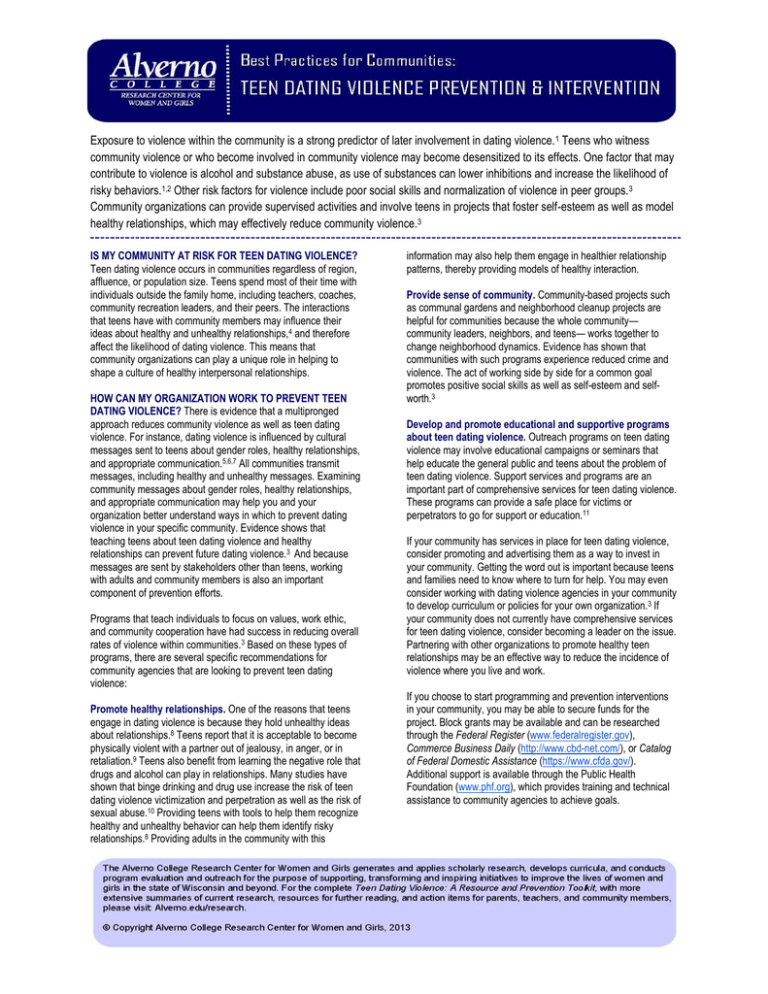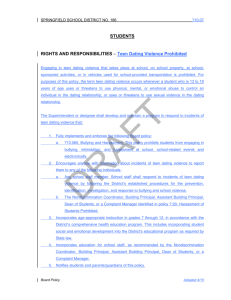Document 10534607
advertisement

Exposure to violence within the community is a strong predictor of later involvement in dating violence. 1 Teens who witness community violence or who become involved in community violence may become desensitized to its effects. One factor that may contribute to violence is alcohol and substance abuse, as use of substances can lower inhibitions and increase the likelihood of risky behaviors.1,2 Other risk factors for violence include poor social skills and normalization of violence in peer groups.3 Community organizations can provide supervised activities and involve teens in projects that foster self-esteem as well as model healthy relationships, which may effectively reduce community violence.3 IS MY COMMUNITY AT RISK FOR TEEN DATING VIOLENCE? Teen dating violence occurs in communities regardless of region, affluence, or population size. Teens spend most of their time with individuals outside the family home, including teachers, coaches, community recreation leaders, and their peers. The interactions that teens have with community members may influence their ideas about healthy and unhealthy relationships,4 and therefore affect the likelihood of dating violence. This means that community organizations can play a unique role in helping to shape a culture of healthy interpersonal relationships. HOW CAN MY ORGANIZATION WORK TO PREVENT TEEN DATING VIOLENCE? There is evidence that a multipronged approach reduces community violence as well as teen dating violence. For instance, dating violence is influenced by cultural messages sent to teens about gender roles, healthy relationships, and appropriate communication.5,6,7 All communities transmit messages, including healthy and unhealthy messages. Examining community messages about gender roles, healthy relationships, and appropriate communication may help you and your organization better understand ways in which to prevent dating violence in your specific community. Evidence shows that teaching teens about teen dating violence and healthy relationships can prevent future dating violence.3 And because messages are sent by stakeholders other than teens, working with adults and community members is also an important component of prevention efforts. Programs that teach individuals to focus on values, work ethic, and community cooperation have had success in reducing overall rates of violence within communities.3 Based on these types of programs, there are several specific recommendations for community agencies that are looking to prevent teen dating violence: Promote healthy relationships. One of the reasons that teens engage in dating violence is because they hold unhealthy ideas about relationships.8 Teens report that it is acceptable to become physically violent with a partner out of jealousy, in anger, or in retaliation.9 Teens also benefit from learning the negative role that drugs and alcohol can play in relationships. Many studies have shown that binge drinking and drug use increase the risk of teen dating violence victimization and perpetration as well as the risk of sexual abuse.10 Providing teens with tools to help them recognize healthy and unhealthy behavior can help them identify risky relationships.8 Providing adults in the community with this information may also help them engage in healthier relationship patterns, thereby providing models of healthy interaction. Provide sense of community. Community-based projects such as communal gardens and neighborhood cleanup projects are helpful for communities because the whole community— community leaders, neighbors, and teens— works together to change neighborhood dynamics. Evidence has shown that communities with such programs experience reduced crime and violence. The act of working side by side for a common goal promotes positive social skills as well as self-esteem and selfworth.3 Develop and promote educational and supportive programs about teen dating violence. Outreach programs on teen dating violence may involve educational campaigns or seminars that help educate the general public and teens about the problem of teen dating violence. Support services and programs are an important part of comprehensive services for teen dating violence. These programs can provide a safe place for victims or perpetrators to go for support or education.11 If your community has services in place for teen dating violence, consider promoting and advertising them as a way to invest in your community. Getting the word out is important because teens and families need to know where to turn for help. You may even consider working with dating violence agencies in your community to develop curriculum or policies for your own organization.3 If your community does not currently have comprehensive services for teen dating violence, consider becoming a leader on the issue. Partnering with other organizations to promote healthy teen relationships may be an effective way to reduce the incidence of violence where you live and work. If you choose to start programming and prevention interventions in your community, you may be able to secure funds for the project. Block grants may be available and can be researched through the Federal Register (www.federalregister.gov), Commerce Business Daily (http://www.cbd-net.com/), or Catalog of Federal Domestic Assistance (https://www.cfda.gov/). Additional support is available through the Public Health Foundation (www.phf.org), which provides training and technical assistance to community agencies to achieve goals.


